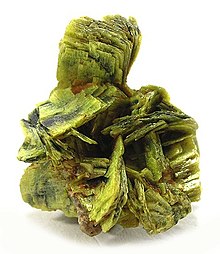
Back Autuniet Afrikaans أوتونيت Arabic Autunita AST Отунит Bulgarian Autunita Catalan Autunit Czech Autunit Danish Autunit German Ωτουνίτης Greek Autunita Spanish
| Autunite | |
|---|---|
 Autunite from Daybreak Mine, Washington | |
| General | |
| Category | Phosphate minerals |
| Formula (repeating unit) | Ca(UO2)2(PO4)2·10–12H2O |
| IMA symbol | Aut[1] |
| Strunz classification | 8.EB.05 |
| Crystal system | Orthorhombic |
| Crystal class | Dipyramidal (mmm) H-M symbol: (2/m 2/m 2/m) |
| Space group | Pnma |
| Unit cell | a = 14.0135(6), b = 20.7121(8), c = 6.9959(3) [Å]; Z = 4 |
| Identification | |
| Formula mass | 986.26 g/mol |
| Color | Lemon-yellow to sulfur-yellow, greenish yellow to pale green; may be dark green to greenish black |
| Crystal habit | Tabular crystals, foliated or scaly aggregates, and in crusts |
| Twinning | Rare on {110} |
| Cleavage | {001} perfect, {100} and {010} poor |
| Fracture | uneven |
| Mohs scale hardness | 2–2.5 |
| Luster | Vitreous – pearly |
| Streak | Pale yellow |
| Diaphaneity | Transparent to translucent |
| Specific gravity | 3.1–3.2 |
| Density | 3.15 |
| Optical properties | Biaxial (−) |
| Refractive index | nα = 1.553 – 1.555 nβ = 1.575 nγ = 1.577 – 1.578 |
| Birefringence | δ = 0.003 |
| Pleochroism | X = colorless to pale yellow; Y = Z = yellow to dark yellow |
| 2V angle | Measured: 10° to 53° |
| Ultraviolet fluorescence | Strong yellow-green fluorescence in UV; Radioactive |
| Solubility | Soluble in acids |
| Alters to | Dehydrates in air |
| Other characteristics | Pseudotetragonal for synthetic material, |
| References | [2][3] |
Autunite (hydrated calcium uranyl phosphate), with formula Ca(UO2)2(PO4)2·10–12H2O, is a yellow-greenish fluorescent phosphate mineral with a hardness of 2–2+1⁄2.[4][5] Autunite crystallizes in the orthorhombic system and often occurs as tabular square crystals, commonly in small crusts or in fan-like masses. Due to the moderate uranium content of 48.27% it is radioactive and also used as uranium ore. Autunite fluoresces bright green to lime green under UV light. The mineral is also called calco-uranite, but this name is rarely used and effectively outdated.[6]
Autunite was discovered in 1852 near Autun, France, which is also autunite's namesake. It occurs as an oxidation product of uranium minerals in granite pegmatites and hydrothermal deposits. Associate minerals include metaautunite, torbernite, phosphuranylite, saleeite, uranophane and sabugalite.[3]
- ^ Warr, L.N. (2021). "IMA–CNMNC approved mineral symbols". Mineralogical Magazine. 85 (3): 291–320. Bibcode:2021MinM...85..291W. doi:10.1180/mgm.2021.43. S2CID 235729616.
- ^ Mindat.org
- ^ a b Handbook of Mineralogy
- ^ Barthelmy, Dave. "Autunite Mineral Data". webmineral.com. Retrieved 2018-01-26.
- ^ "Autunite: Autunite mineral information and data". www.mindat.org. Retrieved 2018-04-28.
- ^ . Encyclopædia Britannica. Vol. 03 (11th ed.). 1911.